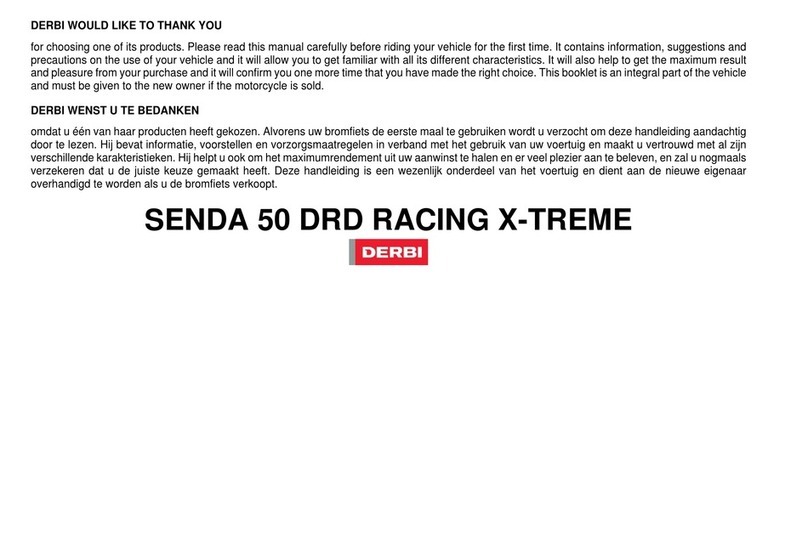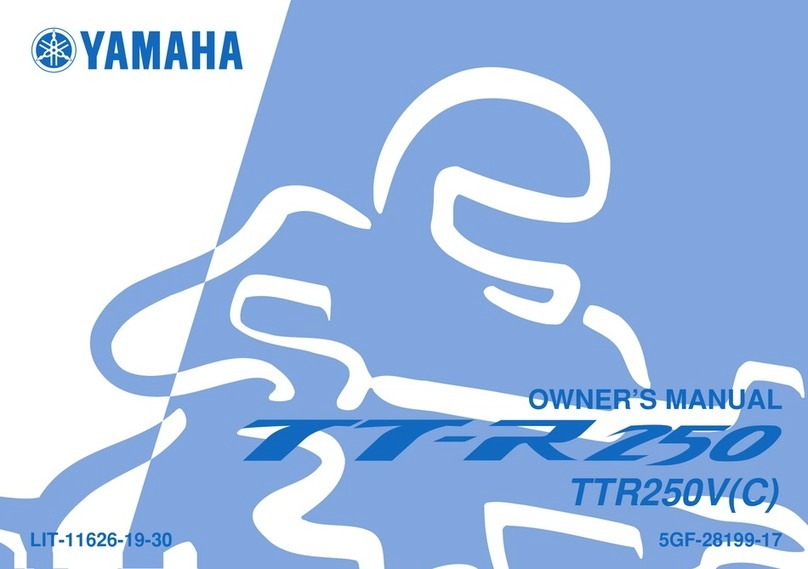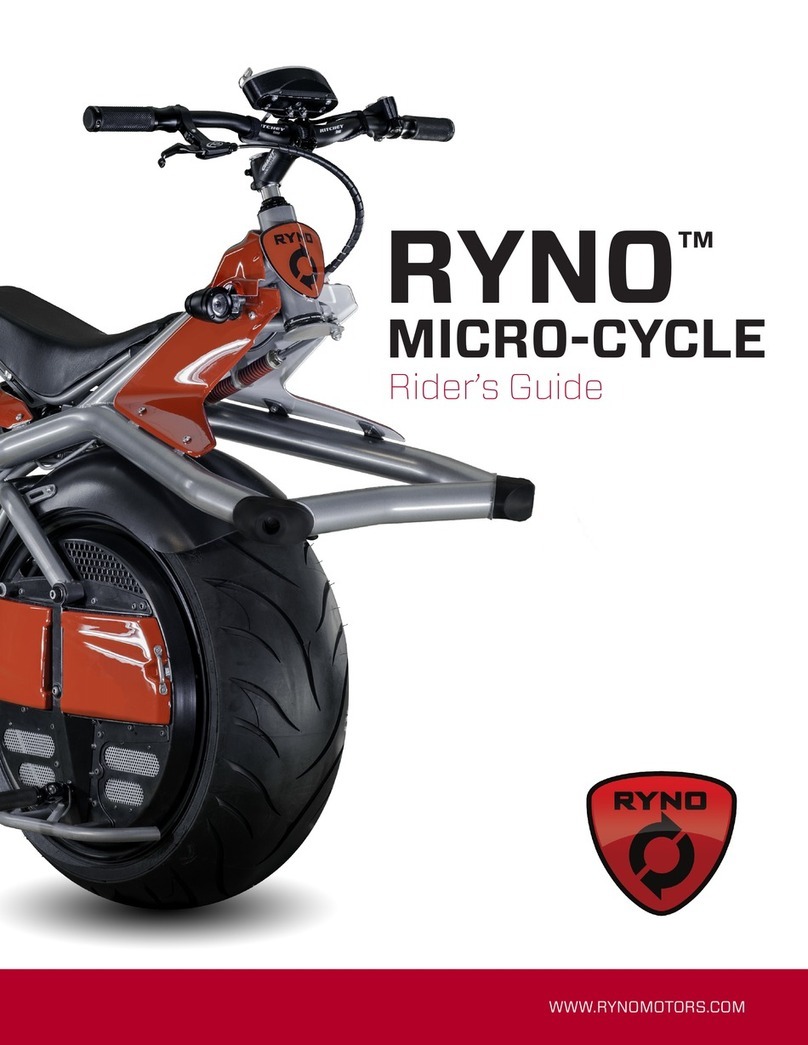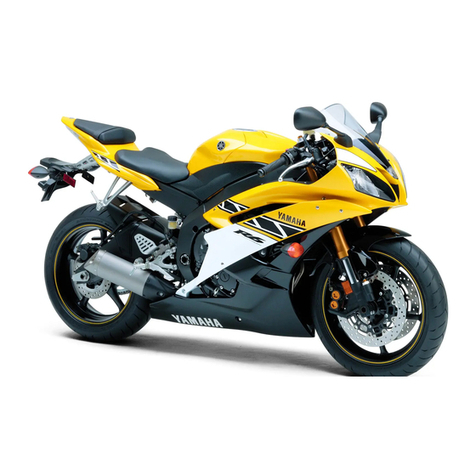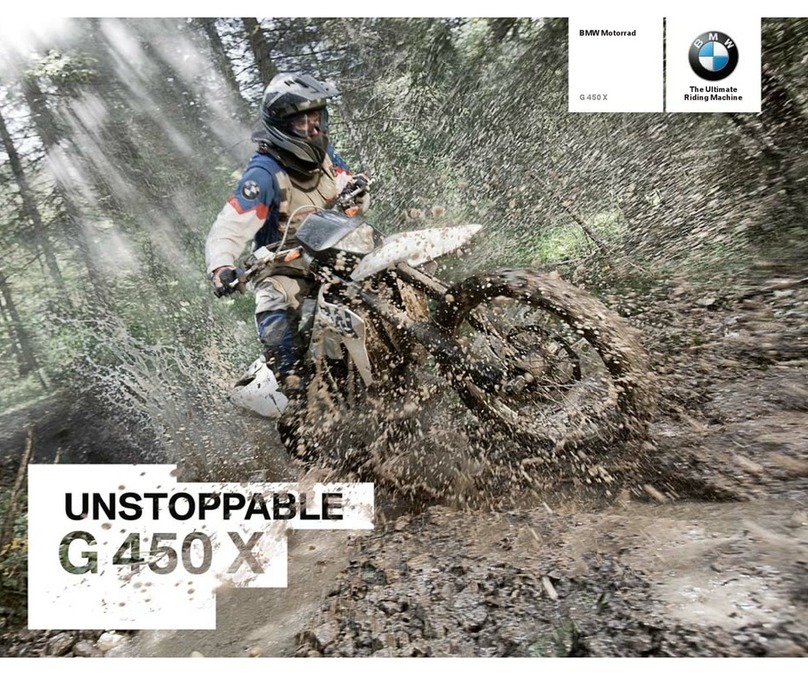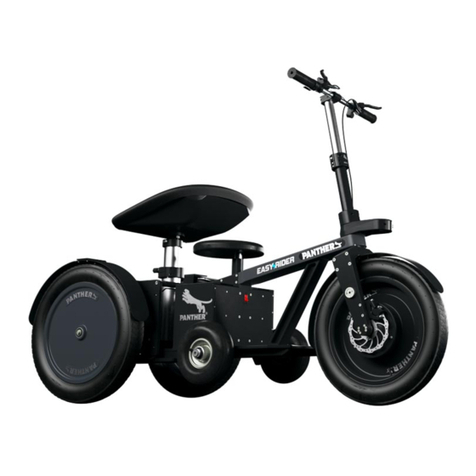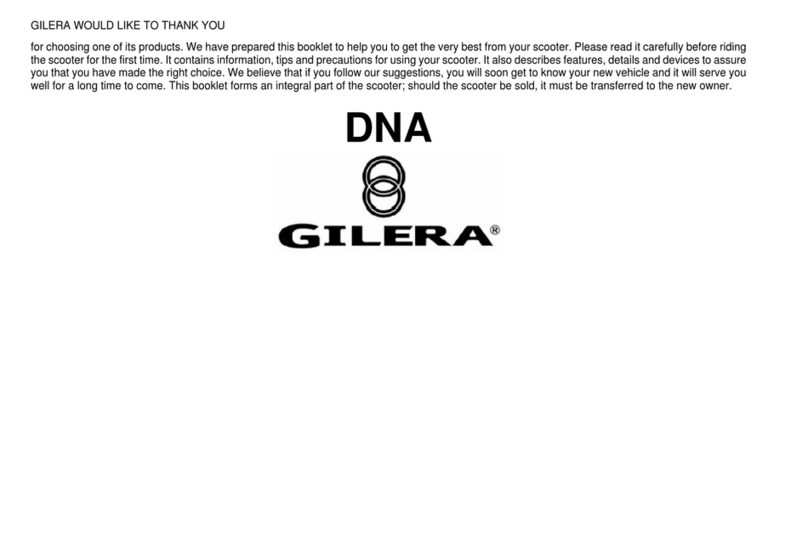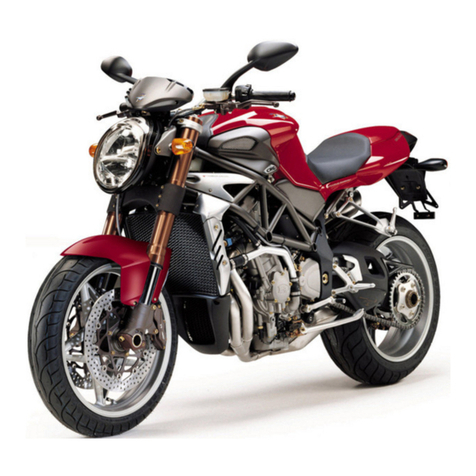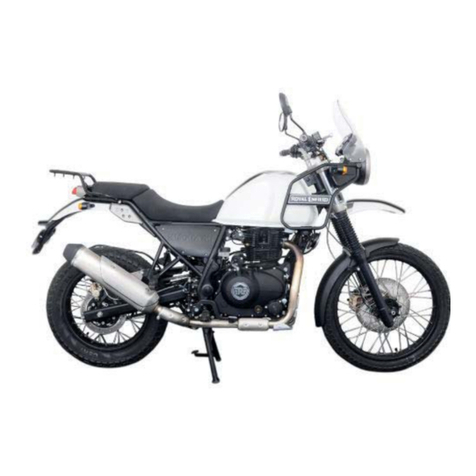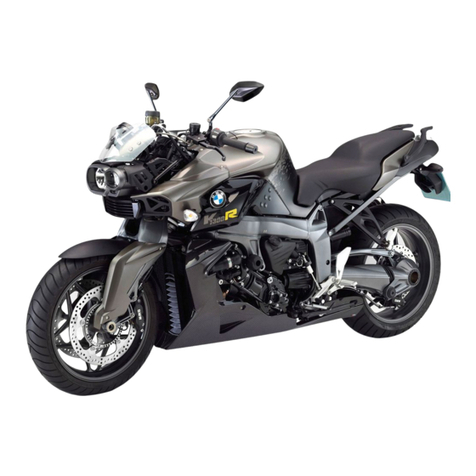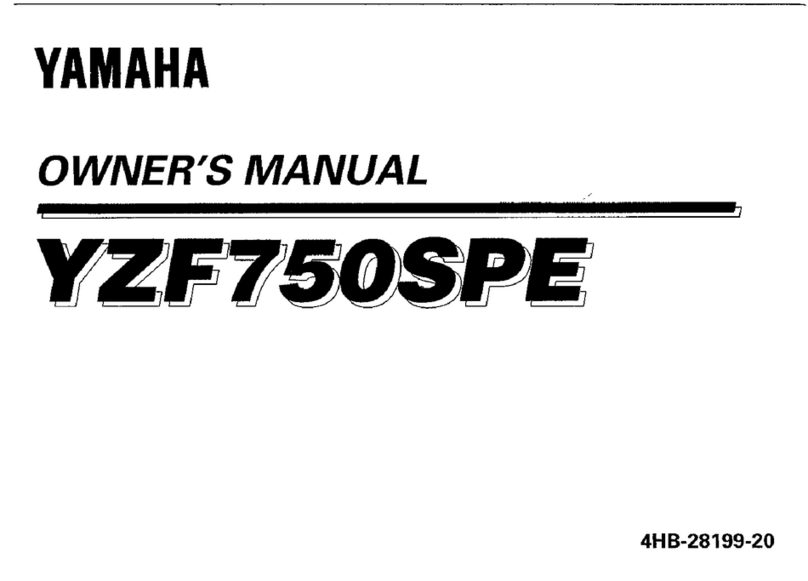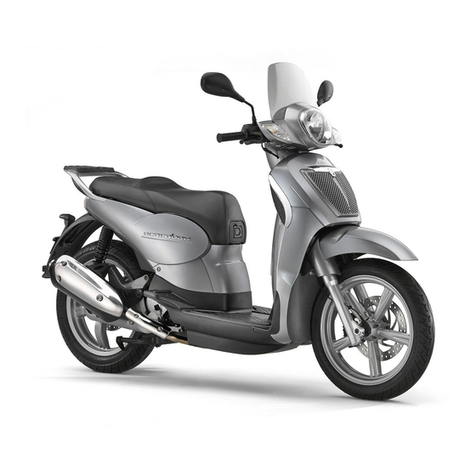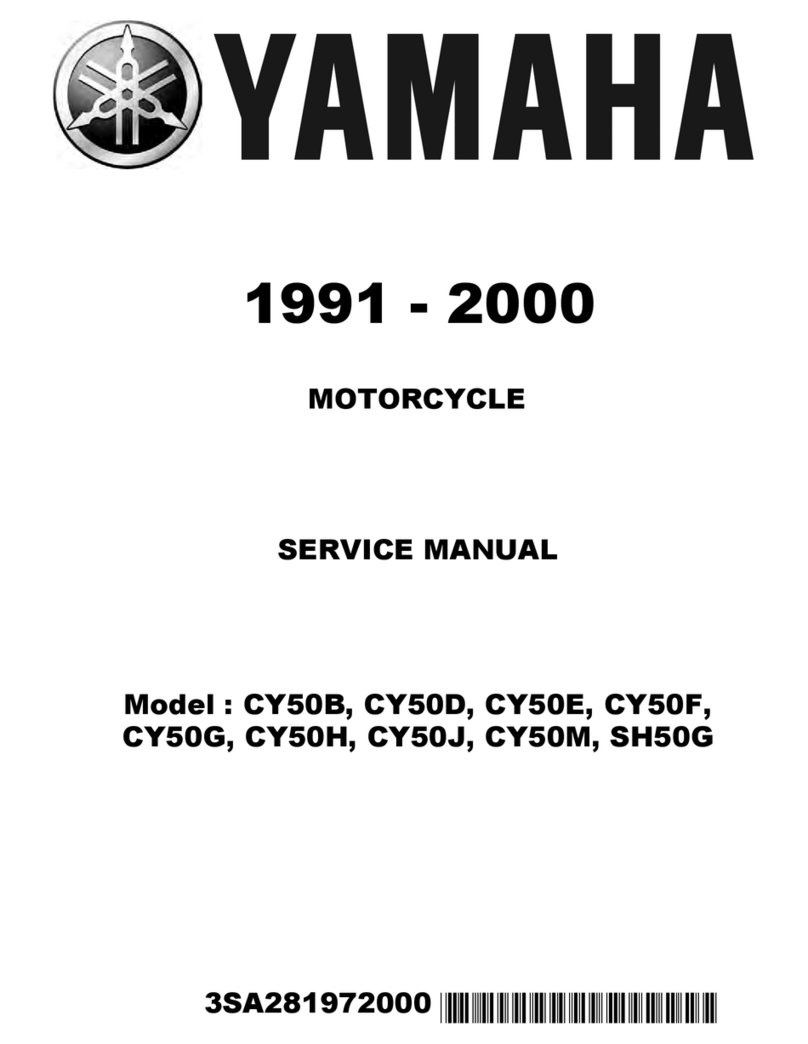Hebo TRS ONE 2021 User manual

User Manual
125 - 250 - 280 - 300
From model year 2021
User Manual - 300,280,250,125cc - (Nov 2020)

2

3
Dear customer,
Thank you for your condence in us, and congratu-
lations on the purchase of your new TRS One.
Because of our experience, professionalism and pas-
sion for trial bikes we are able to oer you an innova-
tive, reliable and up-to-date motorcycle. It has a com-
prehensively checked technical performance that has
been tried and tested both by our technicians and our
high-level drivers worldwide.
The solutions we have used give the motorcycle an
unmistakable character, combining simplicity, re-
liability and design. We pay attention to every last
detail to give you a unique bike.
At the same time, this manual gives you all the in-
formation you need to use the motorcycle appro-
priately and safely. We recommend that you read it
carefully before you use the motorcycle.
In addition, you will nd tips and useful information
for the maintenance and upkeep your new TRS
One.
Yours faithfully,
Welcome to TRS

4
Picture shows homologated version with regard to regulation (EU) Nº168/2013 Picture shows competition version only and is not manufactured for, nor should it be used on
public streets, roads or highways. The use of this kit should be limited to participation in sanc-
tionet competition events upon a closed course.

5
Please read this user manual thoroughly before using your motorcycle. It details all
the instructions for the correct handling of the motorcycle and for your safety, as
well as helping towards the best possible maintenance ¬and upkeep from day one.
Please pay special attention to the notes agged up with the following symbols:
ATTENTION! This symbol refers to points which, if
ignored, could lead to some kind of damage to your
motorcycle. Non-observance of these warnings
could render your motorcycle warranty void.
CAUTION! This symbol refers to points which, if
ignored, could lead to physical danger for the user.
TRS advises you:
In addition to these specic warnings, the manual gives advice on the best use of
your motorcycle, as well as better adjustment and control of its important features.
TRS reserves the right to make changes to this manual.

6
If you have any doubts about adjustments to your
motorcycle, refer to the manual and/or contact an
authorised TRS dealer.
Please carefully read through the information in the
user manual to familiarise yourself with the features
of your motorcycle before driving it using the maxi-
mum power settings.
• A running-in period of at least 8-10 hours without
driving at high speeds or full throttle is advised, in
order to allow the engine to bed in. In these rst
hours, drive at a moderate speed only.
• Fuel is a highly inammable liquid. Use caution
when refuelling and always¬ turn o the engine
rst.
• Before running the engine at high speed, it is im-
portant to let it reach an optimum operating tempe-
rature, especially when starting up the motorcycle
or in low temperature conditions.
• This motorcycle uses two-stroke synthetic oil
mixed with 1% 98 octane fuel. Do not use any other
kind of lubrication without previously checking
with an authorised TRS mechanic.
• This motorcycle is designed to carry just one per-
son, and it is not permitted to carry a passenger.
• For a long life of service, keep the motorcycle
maintained as recommended¬ in this manual.
• This bike is designed to be safe when driving, pro-
vided that the driver is equipped with the appro-
priate safety equipment (helmet, protective clo-
thing, etc.). Be careful and drive sensibly.
TRS recommends:

7
7
1 - Description of parts 8
2 - Technical specifications TRS One - Engine 12
3 - Technical specifications TRS One - Frame 13
4 - Manufacturer’s plate (under the fuel tank) 14
5 - Unboxing, set up 15
6 - Starting and stopping the engine 16
7 - Choke 16
8 - Gearshift 18
9 - Fuel tap 18
10 - Fuel tank 20
11 - Tyres 21
12 - Braking system 22
13 - Steering lock 23
14 - Side stand 23
15 - Handlebar and Instrument panel 24
16 - Adjustment of the levers and the handlebar 26
17 - Changing the transmission oil 26
18 - Spark plug 28
19 - Air Filter 28
20 - Cooling system 29
21 - Draining of coolant 29
Index
22 - Temperature switch 29
23 - Filling with coolant 30
24 - Bleeding air in the cooling system 30
25 - Carburettor 31
26 - Carburetion of the mixture 31
27 - Carburator adjustment of the idle speed 31
28 - Front suspension 33
29 - Rear suspension 33
30 - Drive chain 34
31 - Reed valve 35
32 - Swing arm 35
33 - Rear brake pedal 35
34 - Footrest 36
35 - Exhaust muffler 36
36 - Tank clutch pump 36
37 - Motorcycle maintenance 37
38 - Pares de Apriete 37
39 - Storage 38
40 - Maintenance operations 39
41 - Approval 41
42 - Xtrack Kit 42
43 - Troubleshooting and Frequently Asked Questions 43
44 - Recommended products 47

8
01
02
12
08 27
15
13
25
14
28
03
17
04
07
19
18
11
20
21
22
05
24
32 33
09
1- Clutch lever
2- Indicator, horn and stop buttons
3- Brake lever
4- Accelerator
5- Radiator cap
6 - Fuel tank cap
7- kick-start
8- Fuel tap
9- Radiator
10- Radiator bleed screw
11- Rear brake pedal
12- Fuel tank breather
13- Reed valve
14- Drive chain
15- Gear change pedal
1 - Description of parts
10
33
09

9
17- Front fork
18- Spark plug
19 - Exhaust muer
20- Swing arm
21- Exhaust pipe
22- Water pump
23- Front mudguard
24 - Front brake calliper
25- Ignition cover
26 - Air lter cover
27- Carburettor
28 - Rear Sprocket
29 - Front suspension adjustment
30- Footrests
31- Rear mudguard
06
26
30
30
31
22
29
32- Drive sprocket
33 - Drain plug oil engine

10
1- Clutch lever
2- Indicator, horn and stop buttons
3- Brake lever
4- Accelerator
5- Radiator cap
6 - Fuel tank cap
7- kick-start
8- Fuel tank
9- Radiator
10- Radiator bleed screw
11- Rear brake pedal
12- Fuel tank breather
13- Fuel tap
14- Reed valve
15- Drive chain
16- Gear change pedal
1 - Description of parts
01
02
12
08
13
27
16
14
25
15
28
03
17
04
07
19
18
11
20
21
22
05
24
34
32
33
36
09
10
09
36

11
17- Front fork
18- Spark plug
19 - Exhaust muer
20- Swing arm
21- Exhaust pipe
22 - Water pump
23- Front mudguard
24 - Front brake calliper
25- Ignition cover
26 - Air lter cover
27- Carburettor
28 - Rear Sprocket
29 - Front suspension adjustment
30- Footrests
31- Rear mudguard
06
26
30
30
31
23
29
35
32- Drive sprocket
33 - Battery
34 -Engine electric start
35- Switch electric start
36- Draining plug

12
2 - Technical specifications TRS One - Engine
Technical Specications TRS One - Engine
ENGINE:
Single cylinder 2 stroke.
Displacement:
294,1cc - 272,2 cc - 247,7 cc- 125cc
Cooling system:
Liquid cooled.
Bore x stroke:
79x60 mm (300 cc) - 76x60 mm (280 cc) - 72,5x60 mm (250 cc) - 54x54,6 (125cc)
Ignition:
HIDRIA CDI (double spark).
Clutch:
3 disks diaphragm TRS hydraulic system.
Gearbox:
5 speeds.
Engine oil capacity:
Engine oil capacity (125cc):
330 ml standard engine (relled in 280ml) / 430 ml Electric start version (relled in 380ml)(Nils
clutch trial)
350cc (relled 330cc) (Nils Clutch trial)
Transmission:
Chain.
Fuel:
2,5L Petrol unlead 98 2 stroke oil 1%
Carburettor:
Keihin pwk 28
Starting:
Kick start to primary transmission / Kick-start & Electric Start
Air lter:
Foam.
Spark:
(250-280-300)cc NGK-R BPMR6A / (125)cc NGK BR7ES

13
TRS Motorcycles recommend NILS lubricant.
CHASSIS:
Double cradle forged aluminum frame.
Swing arm:
Aluminium.
Front suspension:
Aluminium Tech, 39mm diameter, 175mm str.
Setting:
Adjustable spring, preload, compression, extension.
Rear suspension:
Reiger 2 ways
Setting:
Spring preload and extension / Spring preload, compresion, extension
Stroke-travel:
Rear wheel stroke 168mm.
Wheel:
Morad aluminium radiated wheel.
Front-wheel tyre:
1.6x21 Michelin X11 Trial 2.75x21.
Rear-wheel tyre:
2.15x18 Michelin X11 Trial 4.00x18 TL.
Front brake:
Disc 185mm clamp 4 pistons BRAKTEC.
Rear brake:
Disk 150mm clamp 2 pistons BRAKTEC.
Net weight:
Standard: 66 kg / Electric start: 68,5 Kg
Dimensions:
Length x width x height: 2,015 x 830 x 1,125mm.
Seat height:
640mm
Engine Protector:
Aluminium 7075.
Foot rest:
TRRS grip adjustables (+/-) 2,5 mm.
3 - Technical specifications TRS One - Frame
Technical specications TRS One - Frame

14
All motorcycles manufactured by TRS have an identication number stamped
on the frame which also appears in the technical sheet of the documentation
that will be supplied to the user. This number cannot be replaced or changed.
It is stamped on the tube on the right hand side of the frame and may be
required in any technical inspection.
SERIAL NUMBER AND KEY CODE
These numbers are the ones that identify your motorcycle and the
steering lock. Keep a note of them in your manual (e.g. to obtain a copy
of the keys if they are lost).
4 - Manufacturer’s plate (under the fuel tank)
a) The position of the identi-
cation number, located on the
tube on the right hand side of the
frame.
b) The identication number
engine, is located under
of the exhaust pipe
We recommend that you keep a note of the serial
number and the identication details for your
motorcycle to use in the event of theft or to order
spare parts.
a
b

15
SETUP BEFORE USING
For safety reasons, motorcycles TRRS with Electric Start are delivered wi-
thout fuel and oil (only when the transport is air and marime transport) ,
and with the ground connector disconnected to prevent ocurrance during
transport. Follow the instrucons below for seeng up the motorcycle.
1. Locaon of the groundconnector, protected with electrical tape. Then
proceed to connect the ground connector to the chassis. Take o the tape of
the ground connector.
2. Insert the ground connector with the bolt togheter and ghten with an 8
mm wrench to the plate support.
-430 ml Electric start version (relled in 380ml)
recommends
5 - Unboxing , set up
2
1
TOMA DE MASSA /
GROUND CONNECTOR

16
STARTING AND STOPPING THE ENGINE
KICK-START CHOKE
The Stop button is positioned on the left-hand side
of the handlebar, close to your thumb for easy use.
Use the choke when the engine is cold to help star-
ting without damaging the engine. This device,
used correctly, will prevent wear and mechanical
damage by starting the motorcycle in adverse tem-
peratures. It is operated by a black lever located in
the carburettor.
6 - Starting and stopping the engine 7 - Choke
a) Start lever, on the right side of the TRS One
b) Stop button, to the left of the handlebar
c) Kill switch, to the right of the handlebar
f) Choke, in the carburettor
a
b
/
d
It is a safety element, so that , in the event of the pilot
falling, the motorcycle is disconnected. Make sure that
the rider puts the elastic band on the left wrist and is
rmly secured, before starting the motorcycle.
f

17
6 - Starting and stopping the engine 7 - Choke
/
STARTING AND STOPPING THE ENGINE
SWITCH ELECTRIC START CHOKE
The Stop button is positioned on the left-hand side of
the handlebar, close to your thumb for easy use.
Use the choke when the engine is cold to help star-
ting without damaging the engine. This device, used
correctly, will prevent wear and mechanical damage
by starting the motorcycle in adverse temperatures. It
is operated by a black lever located in the carburettor.
b) Stop button, to the left of the handlebar
c) Kill switch, to the right of the handlebar
f) Choke, in the carburettor
d
It is a safety element, so that , in the event of the pilot
falling, the motorcycle is disconnected. Make sure that
the rider puts the elastic band on the left wrist and is
rmly secured, before starting the motorcycle.
a) Electric start switch button, on the right side handlebar
NOTE:
1) Before starting the motorcycle, fold the side
stand.
2) Hold the lever clutch
3) Make sure that the gear shift is in neutral.
4) Choke - unlock black lever when engine is hot
5) Press the
E
lectric start switch button
until the
engine starts. Do not hold the button down for
longer than 10 ‘‘.
If the engine does not start, check the
troubleshooting at the end of this document.
b
f
a

18
GEARSHIFT FUEL TAP
The gearshift is controlled by a pedal on the left-hand side of the vehicle. The
sequence of gears is as shown in the diagram. You must hold down the clutch
lever on the left while changing gear. Neutral position is located between rst
and second gear.
On the left side of the frame, you can nd the fuel tap. The positions of knob is located
above the carburettor. The Knob position are:
- On the right : Closed (OFF)
- On the center: Open (ON)
- On the left: Reserve (RES)
We advise turning o the fuel tap when transporting the motorcycle in a vehicle as
well as when it is not in use for a long period.
8 - Gearshift 9 - Fuel tap
You can nd the rst gear by pushing the lever downwards. For the other gears,
push the lever upwards, moving up a gear each time you push it.
Positions Res, On and O in the fuel tap. There is a sticker on the frame
showing the position.a) Gear shift lever
/
5
4
3
2
N
1
a
b

19
GEARSHIFT FUEL TAP
The gearshift is controlled by a pedal on the left-hand side of the vehicle. The
sequence of gears is as shown in the diagram. You must hold down the clutch
lever on the left while changing gear. Neutral position is located between rst
and second gear.
On the left side of the frame, you can nd the fuel tap.
The position of knob is located above the carburettor. The knob postions are:
- On the right : Closed (OFF)
- On the center: Open (ON)
We advise turning o the fuel tap when transporting the motorcycle in a vehicle as
well as when it is not in use for a long period.
You can nd the rst gear by pushing the lever downwards. For the other gears,
push the lever upwards, moving up a gear each time you push it.
b) Fuel Tap.a) Gear shift lever
5
4
3
2
N
1
a
b
8 - Gearshift 9 - Fuel tap
/

20
10 - Fuel tank
The tank has a capacity of 2.5 litres and should be lled with a mixture of unleaded
petrol and oil. The tank cap is positioned at the top of the tank. Minimum octane
rating of fuel: 98 octanes.
Important. Do not mix vegetable and mineral oil. Keep to the
specied levels and proportions for correct combustion in the
engine. To produce a uniform mixture, rst pour the oil and part
of the petrol into a container, shake and then add the rest of
the petrol. It is more dicult to produce a good mixture at low
temperatures and this should be avoided.
FUEL TANK
This manual suits for next models
5
Table of contents
